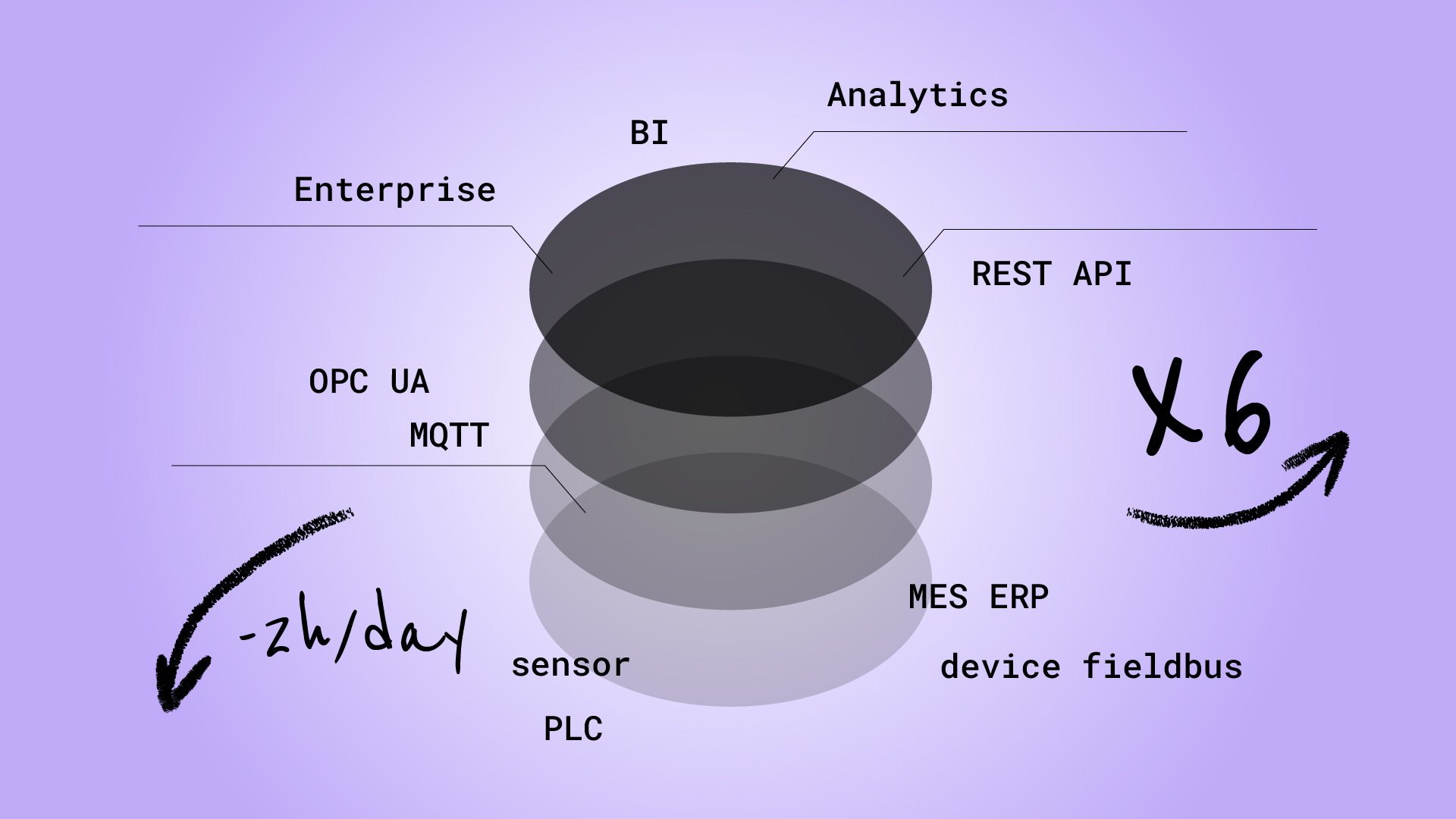
Why is industrial remote access a key factor?

The Internet of Things (IoT) and digitization have changed how industrial machines are controlled and operated. Remote control of PLCs within the IoT has proven to be a key element in optimizing operational efficiency, improving productivity, and reducing costs.
One of the distinguishing features of IoT is the importance of interoperability and standardization in the IoT environment. The adoption of common protocols and standards encourages the interconnection of devices and facilitates the implementation of remote control of machinery.
What are the main benefits of industrial remote access?
This ubiquitous connectivity enables remote monitoring and control of PLCs from anywhere, opening new opportunities to improve productivity and reduce downtime.
Remote control of PLCs allows companies to monitor the performance of machines and lines in real time, collecting data and detailed information on various key parameters.
The analyzed data allow operators to identify inefficiencies or malfunctions, preventing breakdowns or production slowdowns. It leads to reduced downtime and greater overall operational efficiency.
For example, one manufacturing company implemented remote control of its machinery via the IoT. This solution allowed operators to monitor and manage PLCs from a central control unit, eliminating the need to travel between machines.
Thanks to the remote-control mode, the company saw a significant improvement in operational efficiency, reducing downtime by 20% and increasing overall productivity by 15%.
Another manufacturing company adopted remote control of machinery to optimize resource utilization.
With IoT and connected PLCs, operators can track machinery's energy use and find ways to cut waste and improve energy efficiency.
Thanks to remote control, the production sequence can be scheduled efficiently, avoiding overlaps or unnecessary downtime, optimizing the use of resources, reducing production costs, and improving environmental sustainability.
Digitalization and IoT are opening new frontiers for optimizing industrial operations, enabling companies to achieve higher efficiency, productivity, and market competitiveness.
Industrial VPN router for remote access
Remote access via VPN (Virtual Private Network) in the context of IoT is a key solution for secure and reliable machine control. A VPN can establish a secure connection between the control device and the machinery, allowing encrypted and private remote access. This technology plays a crucial role in ensuring the confidentiality, integrity, and authenticity of IoT communications.
A VPN provides an encrypted tunnel between the control device and the machines, creating a virtual private network that protects the information exchanged. This means that communications are secure and safe from potential external threats even if access is through a public network, such as the Internet. Encryption ensures that sensitive data transmitted between the control device and the machines cannot be intercepted or compromised by external attacks.
With VPN, you can securely access machine controls, view monitoring data and obtain information on performance and operational status.
In addition to monitoring, remote access with VPN also allows software updates and configuration parameter changes to be made securely and reliably. Operators can remotely manage the installation of new firmware, apply security patches, and customize machine parameters without having to physically travel to the site. This saves time and resources, simplifies maintenance operations, and improves overall operational efficiency.
Another important aspect of remote access with VPN in the IoT environment is the possibility of granular management of access rights. Through VPN, it is possible to define and control operators' access to different machines and control resources.
This level of control ensures that only authorized persons have access to specific machines and functionalities, protecting the integrity of operations and reducing the risk of abuse or unauthorized access.
VPN allows operators to control machinery, make updates and changes securely and reliably, wherever they are, thanks to the secure and encrypted connection. This technology offers high security, enabling centralized control and optimizing operational efficiency in the IoT environment.
The use of a VPN offers numerous additional advantages to the Alleantia IoT platform.
These include the ability to implement remote access without the need for network intervention for devices already connected with Alleantia, further simplifying configuration, and making the system more flexible.
In addition, the Alleantia gateway's graphical user interface and API allow for intuitive and user-friendly device access management.
By monitoring traffic through the gateway interface or via APIs, it is possible to obtain detailed information on network traffic and communication between devices. This level of monitoring provides operators with an in-depth view of system performance and efficiency, enabling accurate analysis of current activities.
Optimizing operations and maintenance
Optimizing operations and maintenance are one of the main areas of benefit offered by remote control of machinery in the IoT environment, particularly when it comes to remote access to PLCs.
Through IoT connectivity, PLCs can transmit real-time data on their performance, providing operators with a wide range of insights for optimizing operations.
This data contains information on production, efficiency, energy consumed, and other KPIs to evaluate machine performance and identify possible improvements.
With this data, operators can monitor machinery from any location, enabling centralized management and timely decision-making.
They can visualize monitoring data in real time and get a clear view of operations, allowing them to detect deviations.
With seamless connectivity to machinery, operators can receive automatic alerts or analyze monitoring data to detect signs of impending failure.
It allows corrective or preventive maintenance actions to be taken in advance, minimizing downtime and improving overall operational efficiency.
It also enables more efficient planning of maintenance activities. Operators can have a detailed view of the status of machinery, preventive maintenance cycles, and necessary corrective actions, enabling efficient planning of maintenance activities, optimizing resources, and reducing unplanned downtime.
Reducing costs and increasing efficiency
Remote control allows constant monitoring and proactive management of machinery and lines. Operators can gather detailed information on machine performance, thus identifying deviations from the desired parameters and taking corrective measures immediately.
Proactive intervention reduces unplanned downtime and prevents critical failures, optimizing production efficiency and ensuring excellent business continuity.
It also enables centralized management and fast and efficient decision-making. Operators can access monitoring data from different machines and locations in one place, simplifying overall management. It facilitates communication and collaboration across teams, enabling timely and well-informed decision-making.
This strategy offers the possibility of implementing preventive maintenance strategies. By constantly monitoring machinery, operators can identify potential problems or impending breakdowns.
It allows preventive maintenance to be scheduled at reasonable times, avoiding costly production downtime caused by sudden breakdowns, improving efficiency and business continuity, and reducing costs resulting from emergency corrective actions are significantly reduced.
Secure remote access for industrial machinery
The remote control in the IoT environment requires strict attention to cybersecurity, considering the criticality of the operations and data involved.
Connection via VPN (Virtual Private Network) ensures encrypted and secure communication between control devices and connected PLCs.
All information exchanged is encrypted, making it difficult for attackers to intercept or manipulate data such as commands, monitoring, and configuration.
The VPN ensures a private and authenticated connection, limiting access only to authorized users and reducing the risk of unauthorized access.
Robust security practices are also crucial when configuring and managing connected PLCs.
It is advisable to use encrypted passwords to access PLCs, avoiding default or weak passwords that could be easily detectable.
Advanced security systems and robust practices reduce the risk of cyber-attacks and protect sensitive data. The security of connected PLCs is crucial to ensure business continuity and protection of the industrial environment in the IoT era.
In conclusion
In conclusion, remote control of machines in the IoT environment offers several significant advantages for industrial companies.
Integrating PLCs into the IoT ecosystem, it's the right choice if you want centralized management, fast and efficient decision-making, and seamless communication between devices.
Alleantia's IoT platform represents a reliable and efficient solution for PLC integration in the IoT environment.
What are you waiting for?
Boost your business with Alleantia!
CLICK HERE


